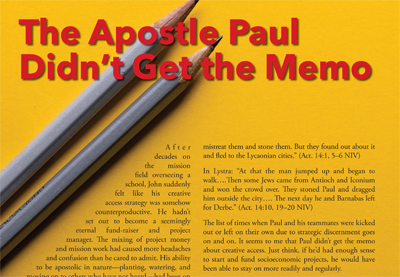The Apostle Paul Didn’t Get the Memo

After decades on the mission field overseeing a school, John suddenly felt like his creative access strategy was somehow counterproductive. He hadn’t set out to become a seemingly eternal fund-raiser and project manager. The mixing of project money and mission work had caused more headaches and confusion than he cared to admit. His ability to be apostolic in nature—planting, watering, and moving on to others who have not heard— had been on hold for twenty years.
Let’s take a detour from John’s journey to look in on the apostle Paul and his companions.
Pisidian Antioch: “The word of the Lord spread through the whole region. But the Jews . . . stirred up persecution against Paul and Barnabas, and expelled them from their region.” (Act. 13:49–59 NIV)
Iconium: “There they spoke so effectively that a great number of Jews and Gentiles believed . . . There was a plot afoot among the Gentiles and Jews, together with their leaders, to mistreat them and stone them. But they found out about it and fled to the Lycaonian cities.” (Act. 14:1, 5–6 NIV)
In Lystra: “At that the man jumped up and began to walk…Then some Jews came from Antioch and Iconium and won the crowd over. They stoned Paul and dragged him outside the city…. The next day he and Barnabas left for Derbe.” (Act. 14:10, 19–20 NIV)
The list of times when Paul and his teammates were kicked out or left on their own due to strategic discernment goes on and on. It seems to me that Paul didn’t get the memo about creative access. Just think, if he’d had enough sense to start and fund socioeconomic projects, he would have been able to stay on more readily and regularly.
You might be asking, “Wow, are you anti-creative access in global missions?” No, I am not. But I am concerned about the way our creative access strategies to gain visas and permanency in countries can be counterproductive to our reason for being in cross-cultural contexts to begin with.
By the way, keep in mind the fact that although Paul, Barnabas and others were unable to stay in any one place very long, they planted sustainable and multiplying faith communities over and over again.
The story of “John” has already alerted us to two concerns in regard to creative access models. One: missionaries become managers rather than planters and fund-raisers rather than mentors. Two: the mixing of project funding and management with gospel work and discipling creates all kinds of confusion, mixed motives, and other problems. Allow me to add a third concern: the majority of our creative access approaches are not reproducible by cultural insiders, either within their own society or when they become missionaries in near cultures. Our mission modeling falls flat on its face when it comes to reproducibility and multiplication.
If all three of these weaknesses run through the veins of our mission work, then our creative access strategies have become counterproductive.
None of us set out with this intention. I would like to encourage you to adapt “phase-out eyes” as you consider your “phase-in eyes.” I came across the terms “phase-in eyes” and “phase-out eyes” via Tom Steffen,1 and I have addressed the practice in my book We Are Not The Hero.2 What often happens is that we work so hard figuring out how to creatively access countries that we forget to consider how to phase-out. The danger of this one-sided approach is that we don’t plan with local sustainability, reproducibility and multiplication in mind. All we care about is how we can gain access and produce fruit. This anemic approach undermines planting and encouraging an indigenous church that multiples many generations of disciples and goes beyond its borders.
As a reminder, the apostle Paul, his team, and his trainees did not rely on the Western-heavy creative access means that we tend to rely on today, and yet they were incredibly successful in reaching their world.
Let’s think more creatively about creative access. Are there ways we can creatively enter unreached people groups without imposing Western models of mission? I am not saying there are easy solutions to the challenges we face, but I do believe we need to keep the conversation going. When we consider our phase-in plan, let’s equally consider our phase-out plan, so we don’t become counterproductive to indigenous, grassroots local disciple and mission movements.
We Are Not The Hero Participant’s Guide and Videos
The readership of the book, We Are Not The Hero, have been asking for a participant’s guide and videos.
We are excited to announce the new release of We Are Not The Hero Participant’s Guide and Videos.
Launch each lesson with the Big Idea delivered through a video. Internalize and explore the content with stimulating Questions to Consider. Ensure you capture the important principles via Sum It All Up and Listen Up, which include proverbs from around the world. Apply the concepts and principles through Action Steps.
We Are Not the Hero provides the cross-cultural thinker and worker with postures, principles, and paradigms for global engagement that promote God’s best version of people around the world, while setting aside their ethnocentric tendencies. In We Are Not the Hero, missionary Jean Johnson shares lessons learned from her sixteen years in Cambodia, in an area known as the Killing Fields, including why our Western culture, church experiences, and financial solutions to church growth are not the answer for the world.
For more information and samples, visit fivestonesglobal. org.
1 Steffen, Tom 1974 Passing the Baton: Church Planting that Empowers. La Habra, CA: Center for Organizational & Ministry Development, 4.
2 Johnson, Jean 2012 We Are Not The Hero: A Missionary’s Guide For Sharing Christ, Not A Culture of Dependency, Sisters, Oregon: DeepRiver Books, 175.








comments